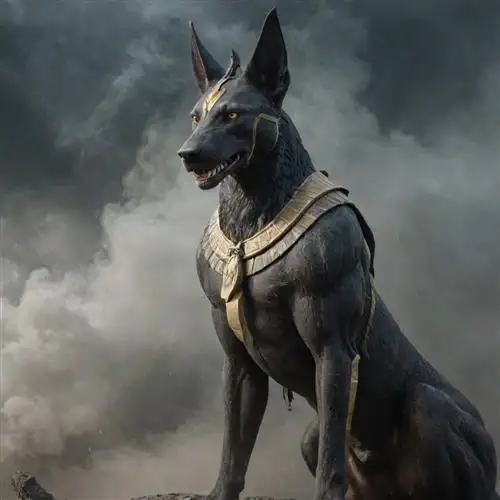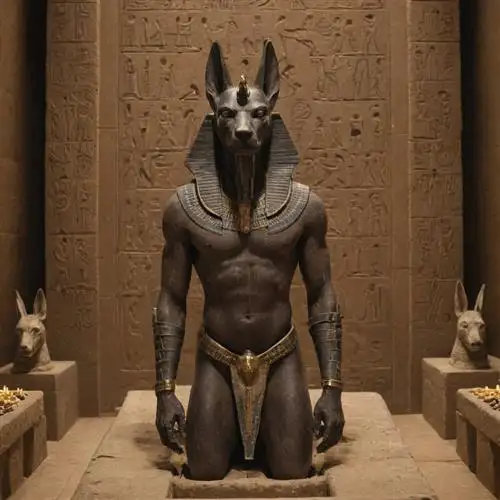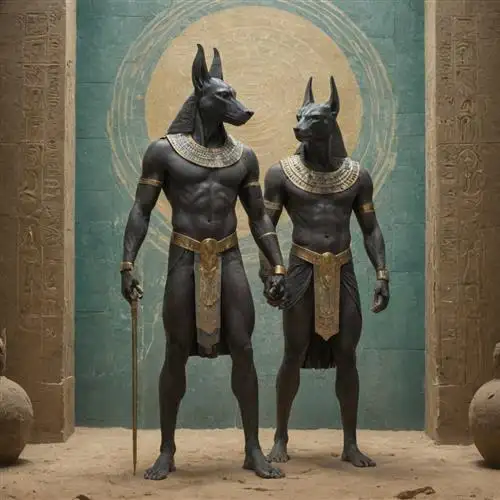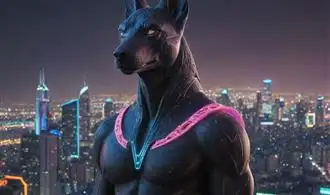
The Jackal-Headed God of Death and Embalming
Anubis, the enigmatic jackal-headed god of ancient Egyptian mythology, has captivated the imaginations of historians, archaeologists, and enthusiasts alike. As the deity associated with death, embalming, and the afterlife, Anubis holds a profound and multifaceted role in the rich tapestry of ancient Egyptian beliefs and practices.
At the core of Anubis' iconography is the jackal, a symbolic representation that has endured through the millennia. The jackal's association with the god can be traced back to the predynastic period, where these cunning canines were observed lingering in the desert regions near burial sites. This proximity to the dead led the ancient Egyptians to revere the jackal as a guardian of the necropolis, a fitting role for the deity who would oversee the delicate process of mummification and the transition to the afterlife.
The depictions of Anubis often feature the distinctive jackal head atop a human body, a visual representation that highlights the god's dual nature. This hybrid form symbolizes Anubis' ability to traverse the realms of the living and the dead, serving as a bridge between the mortal world and the afterlife. In some instances, Anubis is shown in a purely jackal form, further emphasizing his connection to the natural world and his role as a guardian of the dead.
Anubis' primary responsibilities within the Egyptian pantheon were multifaceted, encompassing both the physical and metaphysical aspects of death and the afterlife. As the god of embalming, Anubis was responsible for the mummification process, ensuring the preservation of the deceased's physical form. This crucial role ensured the individual's successful transition to the afterlife, where Anubis would continue to serve as a guide and protector.
Beyond his role in the embalming rituals, Anubis was also entrusted with overseeing the weighing of the heart ceremony, a pivotal moment in the Egyptian conception of the afterlife. In this ritual, the deceased's heart was weighed against the feather of Ma'at, the goddess of truth and justice. If the heart was found to be pure, the individual would be granted passage to the afterlife; if found wanting, the soul would be devoured by the devouring demon Ammit.
The significance of Anubis' iconography extends beyond his physical representation, as the jackal-headed god also served as a symbol of transformation and regeneration. The jackal's ability to thrive in the harsh desert environment was seen as a testament to its resilience, and by extension, Anubis' power to guide the deceased through the challenges of the afterlife.
The Significance of Anubis's Canine Features
Anubis, the Egyptian god of the dead, is often depicted with the head of a jackal or a dog. This distinctive feature holds profound significance in the rich tapestry of ancient Egyptian mythology and symbolism. The canine aspects of Anubis's iconography are deeply rooted in the ancient Egyptians' reverence for the natural world and their understanding of the cyclical nature of life and death.
The jackal or dog-headed representation of Anubis is believed to be a deliberate choice, as these animals were closely associated with the Egyptian underworld and the process of mummification. Jackals and dogs were often observed scavenging near burial sites, leading the Egyptians to believe that they had a unique connection to the realm of the dead. This association with the afterlife and the transition between the world of the living and the dead solidified Anubis's role as the guardian of the necropolis and the protector of the deceased.
Furthermore, the canine features of Anubis symbolize his heightened senses and keen perception, which were essential in his role as the guide and gatekeeper of the underworld. The sharp senses and acute hearing of the jackal or dog were believed to grant Anubis the ability to navigate the complex and often treacherous realms of the afterlife, ensuring the safe passage of the deceased to the next stage of their spiritual journey.
Additionally, the canine characteristics of Anubis were also linked to his role as a judge of the dead. The Egyptians believed that the deceased would undergo a final judgment before the divine council, where their heart would be weighed against the feather of Ma'at, the goddess of truth and justice. Anubis, with his canine instincts and discerning eye, was responsible for overseeing this crucial process, ensuring that the deceased were treated fairly and that their deeds in life were properly accounted for.
The Roles of Anubis in Egyptian Funerary Rites
Anubis, the jackal-headed deity, played a crucial role in the intricate funerary practices of ancient Egypt. As the god associated with mummification and the afterlife, Anubis was a central figure in the complex rituals that accompanied the journey of the deceased from this world to the next.
One of Anubis's primary responsibilities was the mummification process. The ancient Egyptians believed that proper preparation of the body was essential for the soul's successful transition to the afterlife. Anubis oversaw the embalming of the deceased, ensuring the body was carefully preserved and transformed into a vessel capable of housing the spirit.
In the embalming ritual, Anubis was believed to guide the embalmers, providing them with the knowledge and expertise necessary to perform the delicate procedure. The jackal-headed god was also responsible for the removal of the internal organs, which were then placed in canopic jars, protected by the four sons of Horus.
Anubis's role extended beyond the mummification process. He was also responsible for guiding the deceased through the underworld and into the afterlife. During the weighing of the heart ceremony, Anubis would carefully place the heart of the deceased on a scale, balancing it against the feather of truth. This ritual determined the worthiness of the individual, ensuring they were prepared to enter the afterlife.
Additionally, Anubis was believed to be the protector of cemeteries and the guardian of the dead. He was often depicted standing guard over the tomb, ensuring the deceased were safe and their resting place remained undisturbed. Statues and images of Anubis were commonly placed in and around tombs, serving as a constant reminder of his importance in the Egyptian funerary rites.
The Evolution of Anubis's Iconographic Representations
Anubis, the jackal-headed deity of ancient Egyptian mythology, has captivated the imagination of scholars and enthusiasts alike. His iconographic representations have evolved over the centuries, reflecting the shifting cultural and religious landscape of the Nile Valley. Exploring the nuances of these visual depictions offers a fascinating glimpse into the evolving symbolism and significance of this enigmatic figure.
During the Early Dynastic period, Anubis was often portrayed as a fully jackal-headed figure, emphasizing his animalistic nature and his association with the underworld. These early representations highlighted his role as the guardian of the dead, responsible for the embalming process and the protection of the deceased. The jackal form was a deliberate choice, as the jackal was a scavenger that frequented cemeteries and was believed to possess intimate knowledge of the afterlife.
As the Old Kingdom progressed, the iconography of Anubis began to shift. While the jackal head remained a central feature, the body was increasingly depicted in a more human-like form, blending the divine and the mortal. This transformation reflected a growing tendency to anthropomorphize the Egyptian deities, allowing the faithful to relate to them on a more personal level. The incorporation of human elements into Anubis's representation also signified his role as a mediator between the living and the dead, bridging the gap between the earthly and the celestial realms.
During the New Kingdom, Anubis's iconography underwent further refinement. The jackal head was often depicted with a more pronounced snout and pointed ears, emphasizing his animalistic qualities. However, the body was now consistently portrayed in a fully human form, with Anubis wearing the traditional pharaonic regalia, such as the double crown or the crown of Upper Egypt. This fusion of animal and human characteristics underscored Anubis's dual nature, as both a divine entity and a guardian of the dead.
In the later periods of ancient Egyptian history, Anubis's iconographic representations became more diverse and complex. While the jackal-headed form remained the most recognizable depiction, other variations emerged, such as the depiction of Anubis as a fully human figure with only the jackal's head or a jackal-headed figure with a canine body. These adaptations reflect the ongoing evolution of Anubis's symbolic role and the creative expression of the Egyptian artists and artisans who sought to capture the essence of this multifaceted deity.
The Symbolic Relationship Between Anubis and Osiris
The Symbolic Relationship Between Anubis and Osiris is a fascinating aspect of ancient Egyptian mythology that has captivated scholars and enthusiasts alike. Anubis, the jackal-headed god, and Osiris, the god of the afterlife, share a profound connection that goes beyond their individual roles and significance.
At the core of this relationship lies the concept of death and rebirth. Anubis was responsible for the embalming and mummification process, ensuring the preservation of the deceased's body. This crucial step paved the way for the soul's journey into the afterlife, where Osiris reigned as the lord of the dead. The transition from the physical world to the realm of the divine was facilitated by Anubis's meticulous care and guidance.
Interestingly, Anubis's role as the guardian of the dead also extended to his association with Osiris. In some traditions, Anubis was believed to be the son of Osiris, further strengthening their symbolic bond. This familial connection underscores the interdependence between the two deities, where Anubis's actions as the embalmer and protector of the dead were essential for Osiris's dominion over the afterlife.
Moreover, the iconography of Anubis and Osiris often depicts their intertwined roles. Anubis is frequently shown standing beside the funerary bier, overseeing the mummification process, while Osiris is portrayed as the central figure in the afterlife, presiding over the judgment of the dead. This visual representation highlights the complementary nature of their responsibilities and the seamless transition from the earthly realm to the divine.
The symbolic relationship between Anubis and Osiris also extends to the concept of rebirth and regeneration. Osiris, as the god of the afterlife, was associated with the cycle of death and renewal, a belief that was central to ancient Egyptian religious thought. Anubis's role as the embalmer and guardian of the dead ensured the preservation of the deceased, enabling their safe passage into the next life and ultimately their rebirth under the guidance of Osiris.
















